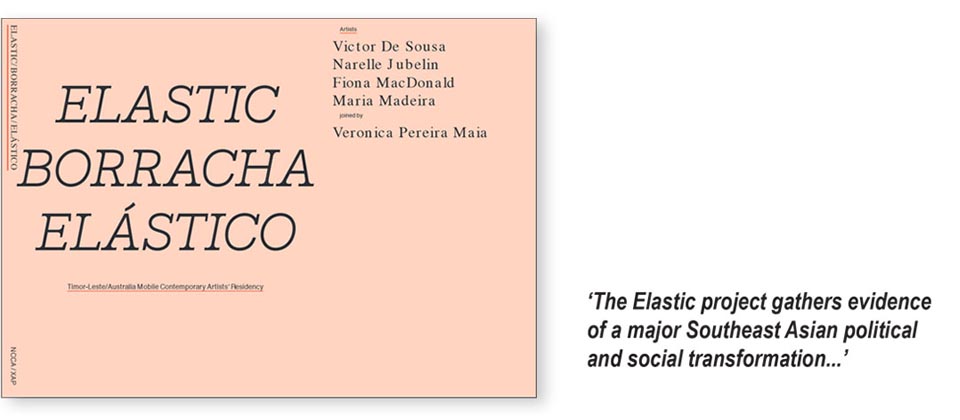
Contemporary Art & Timor Leste
Full title: Elastic Borracha Elástico, Timor-Leste/Australia Mobile Contemporary Artists’ Residency
Published: January 2017 and launched at Northern Territory Library, Darwin, 15 February 2017
Publisher: Northern Centre for Contemporary Art, Darwin and The Cross Art Projects, Sydney;
published with assistance from the Gordon Darling Foundation
Editor: Jo Holder
Authors: Mary Jane Jacob, Jo Holder, Maria Madeira, Veronica Pereira Maia, Maurice O’Riordan,
Sally Anne Watson Kane (trans.)
Designer: Ricardo Felipe
Format: 16cm(w) x 22cm(h)x 1cm(depth), 124pp, paperback (stitch-bound),
60 colour images
ISBN: 978 0 9757791 3 2
rrp: AUD$20
Sales enquiries/orders via:
The Cross Art Projects
8 Llankelly Place, Kings Cross 2011, Sydney, Australia
t: (02) 93572058
e: info@crossart.com.au
above image: cover spread (detail),
Elastic Borracha Elástico;
design: Ricardo Felipe
Index
Book: Elastic/Borracha/Elástico
Timor-Leste Visual Art, Architecture & Culture Database
Timor-Leste Timeline
Elastic Info Flier
Artist Biographies
Acknowledgements
Elastics Print Set
Timor Leste’s 25-year independence struggle was given spirit and form by the silent resilience of traditional culture. Despite achieiving full independence in May 2002, the country was a smoking ruin with 80% of its infrastructure destroyed and communities obliterated. A decade later, four artists – Maria Madeira and Victor De Sousa from East Timor, and Narelle Jubelin and Fiona MacDonald from Australia – formed a mobile residency in 2012. They travelled to 11 of the 13 districts ofTimor-Leste to witness its reconstruction from scorched earth. Their travel was faciliated by Timor Aid and by the late independent Melbourne-based curator Jennifer Phipps to whom the Elastic Borracha Elástico publication is dedicated.
The artists considered the connections between women’s woven textiles (tais), a longstanding form of cultural communication, and the contemporary art world. They also considered vernacular traditions in architecture and political poster art, and the currency of a children’s game like ‘elastics’ as a symbol of the newly independent nation’s regeneration and cross-cultural practice, and of the trickiness of the Australian-East Timor relationship. The artists’ work, produced in collaboration and independently, took form in film, weaving, petit point, painting, printmaking, installation and performance.
Through a partnership involving The Cross Art Projects (Sydney) and the Northern Centre for Contemporary Art (Darwin) Darwin, the Elastic project’s first exhibition was held at the Chan Contemporary Art Space Darwin, followed by a concurrent exhibition at The Cross Art Projects, Sydney (Sept/Oct 2014). In Darwin the mobile residency artists were joined by master weaver and performer Veronica Pereira Maia who allowed her monumental Tais Don (1996) to be exhibited, commemorating the Santa Cruz Massacre in Dili (1991).
Elastic Borracha Elástico is groundbreaking in its aim to build an archive and appreciation for Timor Leste contemporary arts. Included are essays by Jo Holder and Mary Jane Jacob (School of the Art Institute of Chicago) which contextualise the project’s broader artistic and cross-cultural imperatives, and essays in English and Tetum by Veronica Pereira Maia and Maria Madeira. Also features the award-winning Elastic offset lithographic print suite (with Big Fag Press, Sydney) and the ‘Timor-Leste Visual Art, Architecture & Culture Database’ which exists as an online resource: http://crossart.com.au/other-projects/contemporary-art-timor-leste/timor-leste-visual-art-architecture-culture-database
This publication serves as an important record of the Elastic exhibitions and related public programs in Darwin and Sydney which powerfully reignited the spirit and struggle of pre-independence activism while drawing attention to independent East Timor’s current crises including access to Timor Sea oil and gas.
